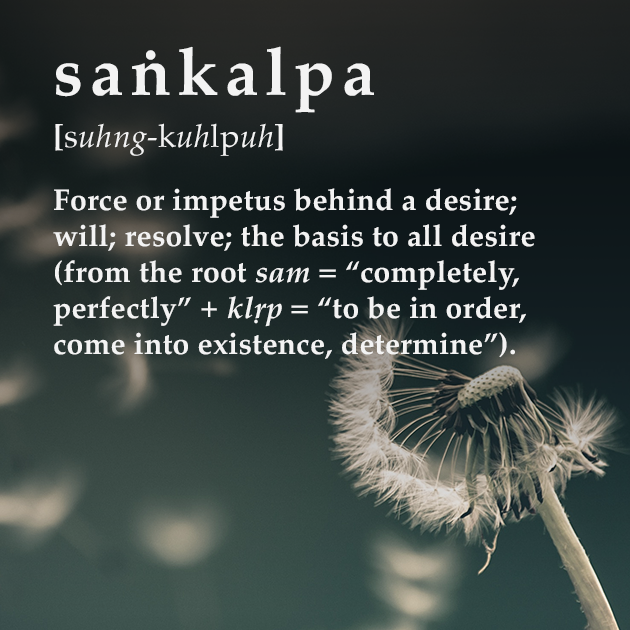What is a sankalpa?

A saṅkalpa is often defined as simply, “a desire.” In Yoga circles it is sometimes described as “intention” or “resolution.” And yet, teachers of Vedanta use it with more nuance. To be exact, a sankalpa is the force or impetus that takes a thought (“Red, shiny, juicy apple”), applies a value or worth to it (“That apple looks delicious”) and turns it into a desire (“I want that apple”). A sankalpa can have a beneficial or negative effect. For example, one might establish a sankalpa that leads to cultivating a more dharmic life, or one might have another kind of sankalpa that projects false attributes onto an object, creates attachment and as a result, leads to suffering.
The wise remind us that it isn’t the senses that create our problems, but the mind and its ability to superimpose fanciful imaginings onto objects, events and relationships. When a thought arises in the mind about a particular object, we can either show indifference, or pin a certain value or worth to it. In turn, applying value to an object evokes emotion, which inevitably leads to a sense of want. If the desire is strong enough, we might begin to think about the object repeatedly until we develop a strong affinity for it. It’s this condition, from thinking “May I have it” to “I need it,” that binds and causes suffering. In such a state, if our desire is thwarted, it leads to anger, which in turn leads to delusion and our ability to make right choices. The Bhagavad Gita tells us “The mind that follows the wandering senses loses its capacity to discriminate, just as an unmanned ship is carried away by the winds of its own destruction.” (2.67). Thus, what starts as a small seed in the mind, has the potential to grow into a state of extreme mental agitation that’s hard or close to impossible to escape from.
It's for these reasons that Vedanta advises to catch an attractive thought early, before it has a chance to create a false narrative or value to it. For example, a person might fall in love with another only based on looks. Standing in a cafe waiting for the barista to make their coffee, a man eyes an attractive woman just feet away. Next, his mind begins to create a whole story regarding her “perfect physique” and “indelible charm” (projections), and the possibility that he has finally found his one and only soul-mate. He might even believe this woman to be the single thing missing in his dull, uneventful life. Next, he imagines them dating, moving in together, marrying, and spending the rest of their life embraced in perfect contentment. All this without having even met her! Thus, what started out as a simple thought (“an attractive woman”), rapidly snowballed into a whole romantic life story about living happily ever after. When his soul-mate finally picks up her coffee and abruptly leaves the cafe, he can't help but to feel a little heartbroken, having not even made eye contact with his newly-made object of desire.
One way to check a sankalpa is by analyzing the object and verifying that it isn’t just a mind construction. We need to put any strong desires under a microscope. When the seed of a desire (sankalpa) arises as a thought, instead of going along with our fanciful imaginings, we can investigate it to see if it reflects the actual truth/reality. Or we can choose to simply ignore it and let it die of its own volition. Like holding a hot potato, any initial discomfort from a sankalpa will dissipate on its own if we just allow it to. Sankalpas only develop into binding desires when we get involved. In the end, all sankalpas are just thoughts. It’s up to us to see them for what they are, and manage them.

Comments